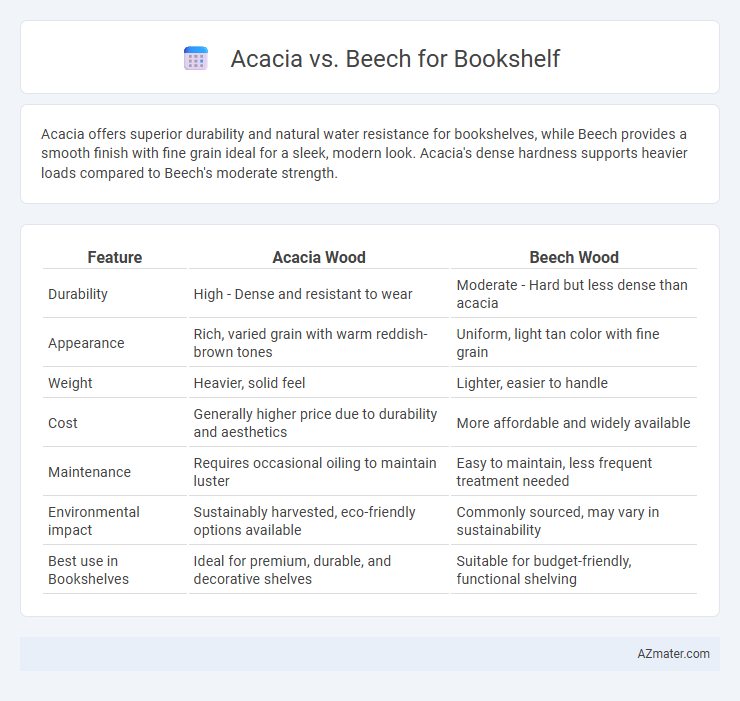Acacia offers superior durability and natural water resistance for bookshelves, while Beech provides a smooth finish with fine grain ideal for a sleek, modern look. Acacia's dense hardness supports heavier loads compared to Beech's moderate strength.
Table of Comparison
| Feature | Acacia Wood | Beech Wood |
|---|---|---|
| Durability | High - Dense and resistant to wear | Moderate - Hard but less dense than acacia |
| Appearance | Rich, varied grain with warm reddish-brown tones | Uniform, light tan color with fine grain |
| Weight | Heavier, solid feel | Lighter, easier to handle |
| Cost | Generally higher price due to durability and aesthetics | More affordable and widely available |
| Maintenance | Requires occasional oiling to maintain luster | Easy to maintain, less frequent treatment needed |
| Environmental impact | Sustainably harvested, eco-friendly options available | Commonly sourced, may vary in sustainability |
| Best use in Bookshelves | Ideal for premium, durable, and decorative shelves | Suitable for budget-friendly, functional shelving |
Overview of Acacia and Beech Wood
Acacia wood, known for its rich, warm tones and natural durability, offers excellent resistance to scratches and moisture, making it a practical choice for bookshelves in diverse environments. Beech wood features a pale cream color with a fine, tight grain, providing a smooth finish and high strength ideal for sturdy and aesthetically versatile bookshelf construction. Both woods stand out for their hardness and resilience, but Acacia's distinctive natural oils enhance longevity, while Beech's uniform texture allows for easy staining and customizing.
Appearance and Grain Patterns
Acacia wood features a rich, warm tone with swirling, irregular grain patterns that create a striking visual contrast, making it ideal for a bold and unique bookshelf design. Beech wood offers a lighter, more uniform color with straight, fine grain patterns that provide a smooth and consistent appearance, perfect for a clean and minimalist aesthetic. The distinct grain texture of Acacia stands out in rustic or eclectic interiors, while Beech complements modern or Scandinavian-style bookshelves with its subtle elegance.
Durability and Strength Comparison
Acacia wood offers superior durability and resistance to scratches and moisture, making it ideal for long-lasting bookshelves exposed to varying conditions. Beech wood is strong and dense but less resistant to water and scratches compared to Acacia, requiring more maintenance to retain its appearance. Both woods provide sturdy structure, but Acacia outperforms Beech in terms of overall strength and durability for bookshelf construction.
Weight and Density Differences
Acacia wood is denser and heavier than beech, typically weighing around 50-65 lbs per cubic foot compared to beech's 40-45 lbs per cubic foot, ensuring enhanced sturdiness for bookshelves. The higher density of acacia provides greater strength and durability, making it ideal for supporting heavier loads without warping or sagging. Beech, being lighter and less dense, offers easier handling and installation but may require additional reinforcement for heavy book collections.
Sustainability and Environmental Impact
Acacia wood, known for its fast growth and high density, offers a more sustainable option for bookshelves compared to beech, which grows slower and requires older trees to be harvested. Acacia's durability and resistance to pests reduce the need for chemical treatments, lowering environmental impact during production and use. Beech, while attractive and strong, often involves higher carbon footprints due to longer growth cycles and intensive processing methods.
Workability and Finishing Qualities
Acacia wood offers excellent workability with its moderate density and fine grain, making it easy to cut, shape, and sand for bookshelf construction. Its natural oils enhance finishing qualities, producing a smooth, glossy surface that resists moisture and wear. Beech wood is also highly workable due to its uniform texture and hardness, allowing precise joinery and a flawless finish, which accepts stains and paints evenly for a polished bookshelf appearance.
Cost and Availability
Acacia wood offers a more affordable option for bookshelves compared to beech, with prices varying based on grade and treatment. Beech is generally more expensive due to its dense hardwood properties and durability, often sourced from Europe, which can limit availability in some regions. Acacia's abundance in tropical areas ensures greater accessibility and lower costs, making it a budget-friendly choice for sturdy, stylish shelves.
Resistance to Warping and Damage
Acacia wood offers superior resistance to warping and damage due to its dense, oily grain structure, making it ideal for durable bookshelves in varying humidity conditions. Beech wood, while hard and strong, is more prone to warping and denting over time, especially in environments with fluctuating moisture levels. Choosing Acacia ensures long-lasting structural integrity and resistance to everyday wear and tear compared to Beech.
Maintenance and Longevity
Acacia wood offers superior durability and natural resistance to scratches and moisture, making it a low-maintenance choice for bookshelves that can last for decades. Beech wood, while strong and stable, requires regular sealing or finishing to prevent moisture damage and maintain its appearance over time. Both woods provide solid longevity, but acacia's dense grain and natural oils reduce the need for frequent upkeep.
Best Choice for Bookshelf: Acacia or Beech?
Acacia offers superior durability and resistance to moisture, making it an excellent choice for sturdy, long-lasting bookshelves, while Beech provides a smoother grain and lighter color that fits well in modern, minimalist designs. Acacia's natural hardness and rich, warm tones enhance aesthetic appeal and structural strength, whereas Beech's fine texture allows for easy staining and a more uniform finish. For high-traffic areas or heavier loads, Acacia outperforms Beech, but Beech remains ideal for lightweight, visually clean shelving solutions.

Infographic: Acacia vs Beech for Bookshelf
 azmater.com
azmater.com